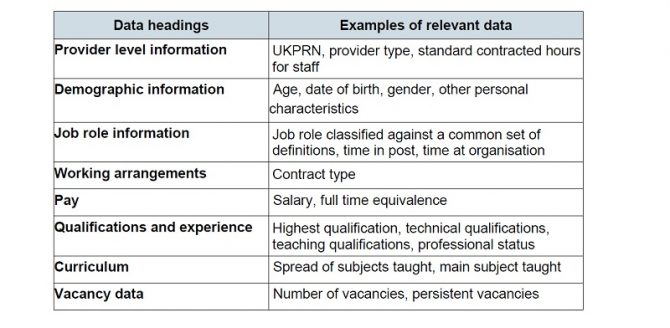The government is to force all colleges and training providers to submit workforce and pay data to “ensure” they can “benchmark themselves against one another”.
Following a consultation last year, which attracted 40 responses, the Department for Education said today the ESFA will gather workforce records for 2020/21, before making compliance mandatory for 2021/22.
Sanctions will be imposed if providers fail to submit the data, which the DfE has said could include a letter from ministers and being publicly named and shamed.
The new data collection will involve the thousands of FE providers in receipt of ESFA funding. Minister Michelle Donelan claimed it will “ensure transparency of workforce data and will seek to ensure that providers can benchmark themselves against one another”.
Thousands of subcontractors will, however, not be involved in the collection for 2020/21 as “data from subcontractors with multi-provider contracts could cause confusion” – so the results would still show a very partial picture.
Data likely to be collected includes staff pay, age, gender, what qualifications they hold, and their contract type (see table).

And it will encompass the whole workforce such as back office support staff, not just lecturers.
Association of Employment and Learning Providers boss Mark Dawe said: “Until we see the detail of what is being collected, it’s very hard to comment.
“But the last thing the sector needs is more bureaucratic burden, so the new system should be designed to limit the administrative impact on all providers.”
The Education and Training Foundation already conducts an annual FE workforce survey, but it is not mandatory and does not usually attract a high number of responses.
Its latest survey, for 2017/18, reflected 90,792 records submitted by just 193 providers, of which 118 were colleges.
University and College Union head of further education, Andrew Harden, said the optional approach to workforce data collection has “failed and we welcome this move to compulsory collection”.
“Good quality data is essential if are to paint an accurate picture of how staff are being treated by employers across the sector,” he added.
In her ministerial forward to the department’s consultation response, Donelan said FE providers “make a real difference to the prospects of learners and local communities” and to support them with policy intervention, government “needs an evidence base that is comprehensive and complete”.
“We will not be designing an FE workforce data collection from scratch,” she added.
“We will draw lessons from practice in existing collections. These changes will give FE workforce data the same status as that of schools and higher education, where we have near full coverage across our workforce datasets.”
The single DfE-led data collection will “sit alongside and complement the other collections that the ESFA is responsible for, such as submissions of learner data, and the functionality will be co-designed with the sector to offer coherence to those inputting data”.
The consultation said officials recognise that collecting information on the entire FE workforce from all providers is a “complex ask”, so it will lead an “extensive programme of user testing with the sector in the lead up to launch, to make sure the collection avoids duplication”.
“We will continue to consider how this approach might be applied to the same providers that are funded by Mayoral Combined Authorities or the Greater London Authority and do not also receive funding from the ESFA,” it added.
The timing of the collection period has not yet been decided, however. The consultation said there was “no clear consensus” on this, so the ESFA will “consult further”.








Lovely.
So, if Training Provider ‘A’ works out that they have paid themselves as the sole business owners less than Training Provider ‘B’, which is an FE College, will the ESFA make up the shortfall to balance it all out?
Following Pareto’s Law, 80% of all ESFA funding will go to Colleges, and their pay scale will reflect their standing in the community, the amount of pay their CEO/Chair receives, bonus payments on achievement, all of which is drawn from either the ESFA or Central Funding.
Meanwhile, the independent training provider only earns money for the learners they have at any one time, completion rates, Functional Skills payments and the like.
Perhaps AELP would like to ask the question in advance:
‘Excuse me ESFA, but you have the stats already – you know how many learners are in the system, you know where those learners are attached in terms of training providers, and you know how much you are paying those providers’.
You don’t think that the ESFA might be looking at funding bands for future years, do you?
Surely not!
Would be interested to know what data they require from Employer Providers and Large Training Providers who have significant activity outside of their FE funded provision. Only providing information on those departments / centres involved in the training will not provide a like for like comparison to providers / colleges who solely provide a training provision.
About time too especially for ITP. There are those out there who have spends of over £200k per month yet employ 3-4 tutors and the question needs to be asked how are they delivering the AEB on those numbers. £200k per month is at least 12 full classes therefore 12 full time tutors if they have 3-4 tutors how are they delivering these courses. This should have been implemented years ago.